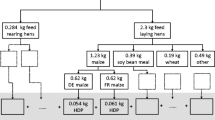Abstract
This paper presents an estimate of the amount of nitrogen involved in the use and trade of feedstuffs for a number of world regions. Livestock production has shown a steady increase world-wide as a result of an annual increase of 1.4% in developing countries and 0.9% in developed countries during the period 1960–1990. Particularly in developing countries, the strong growth of animal production and a tendency towards decreasing reliance on grazing and increasing importance of fodder crops and feed concentrates, cause a major increase in the consumption of feedstuffs. Cereals form the major feedstuff world-wide. The current global use of cereals for feed is about 30% of the total use (57% in developed countries and 17% in developing countries). Net trade of cereals and other feedstuffs represents 4–8 Tg N per year, which is only 4–7% of the total N consumption by the world's animal population. A strong growth of the per capita food consumption, a relative increase of meat consumption, coupled with a strong population growth, may cause a strong increase of the net trade of cereals. In particular the countries of the Middle East, North Africa and China may become important importers of cereals. In future, the N transport between regions in the form of feedstuffs may become an important component in the global N cycle.
Similar content being viewed by others
References
Alexandratos N (ed) (1995) World Agriculture: Towards 2010. An FAO Study. Food and Agriculture Organization of the United Nations, Rome / Wiley and Sons, Chichester. 488 pp
Bouwman (1997) Long-term scenarios of livestock-crop-land use interactions in developing countries. Land and Water Bulletin 6, Food and Agriculture Organization of the United Nations, Rome, 144 pp
Bouwman AF & Van Der Hoek KW (1997) Scenarios of animal waste production and fertilizer use and associated ammonia emission for the developing countries. Atmospheric Environment 31: 4095-4102
Bouwman AF, Van der Hoek KW & Olivier JGJ (1995) Uncertainties in the global source distribution of nitrous oxide. J Geophys Res 100: 2785-2800
CVB (1996) Verkort tabel 1996. Voedernormen landbouwhuisdieren en voederwaarde veevoeders. CVB series #20. Centraal Veevoeder Bureau (CVB), Lelystad, Netherlands
FAO (1996) FAOSTAT. FAO Publications Division. Food and Agriculture Organization of the United Nations, Rome
FAO (1997) FAOSTAT database collections available at internet http://apps.fao.org/default.htm. Food and Agriculture Organization of the United Nations, Rome
UN (1994) World population prospects: the 1994 revision (annex tables). United Nations, New York
Zuidema G, Van den Born GJ, Alcamo J & Kreileman GJJ (1994) Simulating changes in global land cover as affected by economic and climatic factors. Water Air Soil Pollut 76: 163-198
Author information
Authors and Affiliations
Rights and permissions
About this article
Cite this article
Bouwman, A., Booij, H. Global use and trade of feedstuffs and consequences for the nitrogen cycle. Nutrient Cycling in Agroecosystems 52, 261–267 (1998). https://doi.org/10.1023/A:1009763706114
Issue Date:
DOI: https://doi.org/10.1023/A:1009763706114




